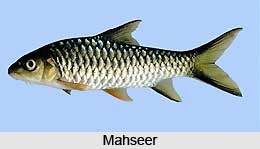 Mahseer belongs to the carp family, Cyprinidae. Five species of genus Tor and one of Acrossocheilus are called mahseers and are found in different parts of the Indian subcontinent. Being marked by large shining scales and four barbles they are also known as `large-scaled barbles`. One species Tor putitora or the common Himalayan mahseer, grows to a length of 2.75 metres while another (probably T.musullah) from the Karnataka rivers is known to have weighed 54.3 kilograms.
Mahseer belongs to the carp family, Cyprinidae. Five species of genus Tor and one of Acrossocheilus are called mahseers and are found in different parts of the Indian subcontinent. Being marked by large shining scales and four barbles they are also known as `large-scaled barbles`. One species Tor putitora or the common Himalayan mahseer, grows to a length of 2.75 metres while another (probably T.musullah) from the Karnataka rivers is known to have weighed 54.3 kilograms.
Mahseers are riverine fish favouring clear waters and deep pools. They can adapt themselves to conditions in large reservoirs also by breeding in the feeder streams. They are omnivorous, feeding on a variety of items available in the waters in which they live. They eat aquatic weeds of all sorts, some taken intentionally, some when grabbing at the insects that live on them; seeds of the Vateria indica or Dhup of West coast, which are about the size of the pigeon`s egg; the seeds of many other trees also which hang over the river when it is forest-clad; bamboo seeds; rice thrown in by man; and unhusked rice, or paddy as it is washed from fields; crabs...small fish, earthworms, water beetles, grasshoppers, small flies of sorts, water or stone crickets, shrimps and molluscs or fresh-water snails, the latter shell and all, and smashed to pieces like the crabs. Observations on Tor tor from Narmada River have shown that the species feeds mainly on vegetation and insects, though other mahseers do take small fish occasionally.
For breeding, mahseers prefer small show-flowing rivers where water is clear, well-oxygenated and the bed is sandy or covered with pebbles. They become sexually mature when about thirty centimetres in length. In northern India, particularly in the Punjab, the fish is said to have three spawning seasons; January to February, may to June and July to September. Among these, from the month of July to the month of August seems to be the most common and it is regarded as the peak period. Spawning in rivers has not yet been observed, but in the waters of Bhimtal in Kumaon of Uttarakhand, males and females are reported to gather together in shallow marginal areas, where amid the splashing of water eggs are laid and fertilized. The eggs are beautiful glistening lemon-yellow or brownish in colour, 2.5 to 3.2 millimetres in diameter, and being heavy with yolk sink to the bottom. They take about eighty hours to hatch in water with a temperature of 26Ø C. The hatchlings of the larvae have a large yolk-sac, yellow in colour and mostly quiescent but they suddenly move with jerky action. They appear to be negatively phototropic, congregating and hiding in crevices till they develop into free-swimming fry. This development takes about six days in the case of the peninsular species. This quiescent condition is a critical stage, when the larvae, huddled up into groups in corners and crevices, are likely to be preyed upon by predatory fish and other organisms. After they become free-swimming they fend for themselves.
Mahseers are great favourites of anglers because of their large size and fighting capacity when hooked. A considerable decline in their numbers has, of late, been reported in the sub-Himalayan Rivers as well as in the south. Efforts are, therefore, being made to rehabilitate these fish by breeding them artificially and introducing fry and fingerlings into different waters.



















